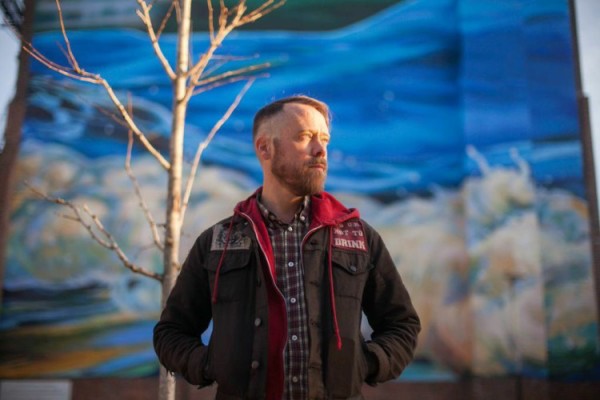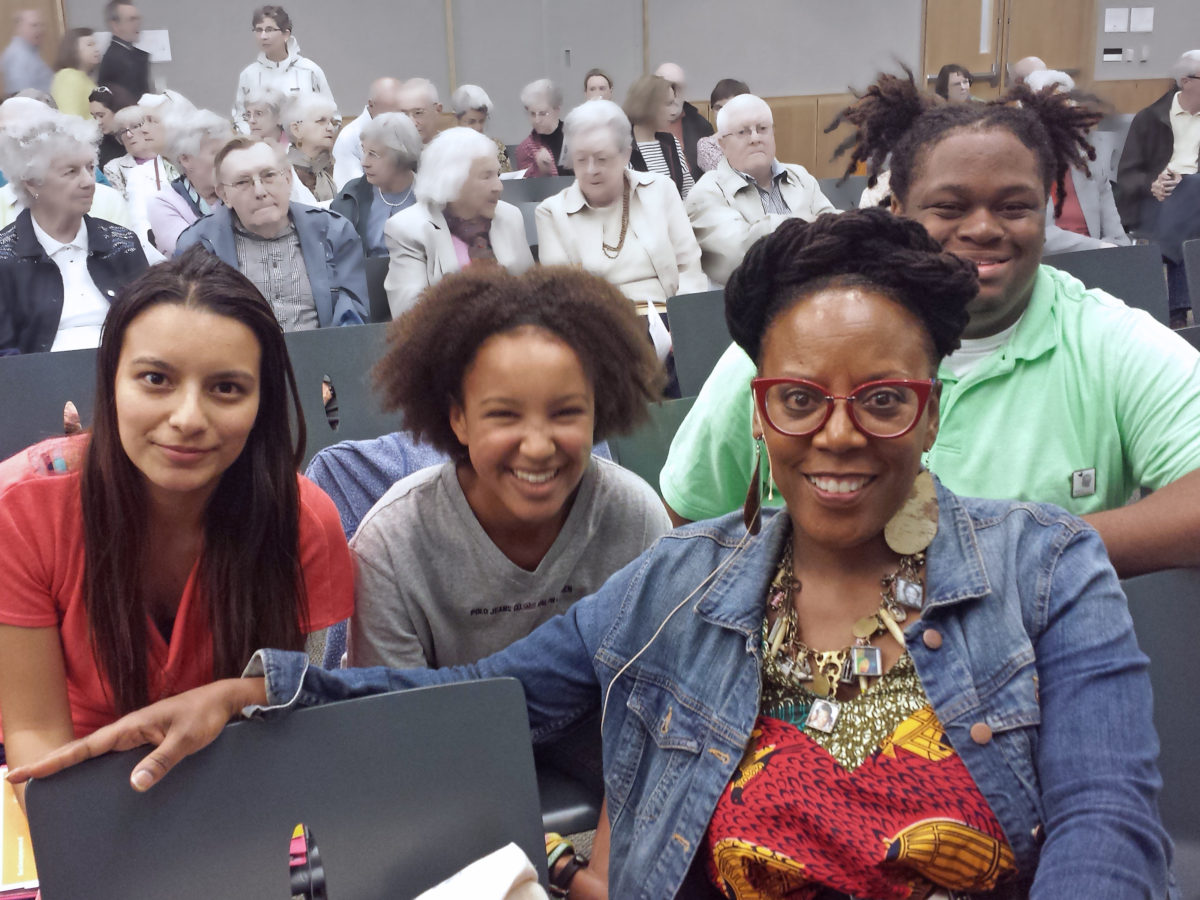Building students’ confidence in presenting work aloud is an important part of many writing programs, and stage fright can affect writers and performers at any age. In this lesson plan, writer and performance artist Jared Paul offers strategies to help students prepare for performance.
Whether sharing poems in a classroom, at a youth poetry slam, or during a Poetry Out Loud competition, presenting in front of a live audience can be a stressful experience. It’s easy to imagine any number of things going wrong with the attention of a room full of people bearing down on us: What if I forget a line? Will I lose my train of thought? What if no one “gets” my poem or cares what I have to say? Stage fright is a real obstacle for many people. As a performance artist who’s been on hundreds of stages across the US, Canada, and Europe, I’ve spent many hours practicing, performing, and coaching peers and students. I’ve learned that people have varying degrees of natural performance ability, but with the right preparation and understanding of context, anyone can deliver a confident, effective performance.
Most of the work for honest and effective performance art is done long before we get to the stage. If we’ve got content that we believe in, edited, and rehearsed to the best of our ability, then we’ve already won half the battle. An athlete doesn’t step onto the field without practicing or knowing the next play, and a pianist couldn’t give much of recital without rehearsing the material. Yet so many times, open mic participants walk on stage with a poem they haven’t finished yet and have never even read aloud before. For instance, someone steps up to the mic with a poem she wrote on a napkin when inspiration struck or typed in an e-mail to herself. The stage lights are bright, the napkin is creased, and the words are harder to read than expected. Or the phone’s energy saver turns the screen dark in the middle of a line; maybe the page suddenly won’t load at all. Every little stutter or flub seems amplified. Nervousness increases and an unproductive inner dialogue begins: Why am I messing this up? I wish I had printed this more clearly…
The poem doesn’t come out the way we hoped, and we walk away feeling like stage fright got us again. Or maybe that I’m not good at public speaking. In reality, we haven’t given the actual power of our performance ability or creative writing a chance because we got in front of the crowd and shared unfinished work. If we don’t practice in real time before the show, we don’t know what the piece sounds like at full volume—we don’t have the best understanding of where the rises and falls in tone and energy are. Errors are more likely to happen when we aren’t comfortable with the line breaks or flow, when we haven’t practiced how to begin the piece or how to maintain the energy and nuance all the way through to the end of the performance.
In my experience, whether young writers are preparing to recite another author’s work for a competition like Poetry Out Loud or reading original pieces for a youth poetry slam, almost all stage fright can be resolved through four basic steps of Pre-Performance Preparation: 1. Completion of Content, 2. Best Performance Practices (repetitions in the flight simulator), 3. Understanding the Appropriateness of Setting, and 4. Transforming Nervousness into Excitement.
1. Completion of Content: Making sure the words on the page are ready to be shared.
For me, the first step to a great performance is making sure that I only step to the stage with content that I believe in and am excited to share. Whether the material is funny, political, or personal, believing in the ideas and concept of the art we perform is the fuel and conviction that anchors us throughout the presentation. When we’ve got that kind of work, and we’ve gone over it to the best of our ability (including editing out redundancies and removing all text that doesn’t make the piece stronger if it’s something we wrote), then we shift focus to presentation and performance.
If we take the stage with work we’re not excited about or don’t really believe in, then it’s difficult to step to the mic and commit—harder to maintain energy and focus throughout the piece, and to recover from mistakes that might naturally occur. Whether it’s our own material or the recitation of someone else’s, presenting completed work that we’re excited about and fully committed to is critical for an effective performance.
2. Best Performance Practices: Repetitions in the flight simulator.
Once we’ve selected another poet’s work that we’re truly excited about sharing, or we’re sure the text of one of our own pieces is edited to completion, then we can focus on performance preparation. I’d like to note that the effectiveness of a poetry performance is not exclusive to memorized work. Some of the best poets in the world win over enormous audiences at festivals, protests, and conferences reciting from the page. A clear example of this is Maya Angelou’s reading of her original poem “On the Pulse of Morning” at Bill Clinton’s first Inauguration. She dazzled a crowd of thousands without raising her voice or using choreographed slam performance because the piece was beautifully written, carefully edited, and printed clearly in easily readable text; and she read the work with confidence and passion.
Not everyone can be Maya Angelou, but I believe everyone is an artist and capable of communicating with an audience. We’ve just got to create something we believe in and prepare seriously so that we’re ready before we hit the stage. Once we get this down, we begin to develop a sense of our personal best practices for performance preparation, and then we can use that process again and again.
Once I’ve completed a piece or found another’s work that I’m passionate about sharing, I decide whether it’s something that I’m going to read from the page or memorize for an off-page performance. Either way, I practice regularly until I feel as excited about the performance as I do about the content.
If it’s a piece I’m committing to memory, I go over lines in my head all day: on walks to the store, in the shower, and on bus rides. I repeat the lines over and over until I can go through the whole piece without messing up. Then, I practice the performance aloud in my room, keeping my feet shoulder length apart with my back straight. Good posture when performing keeps airways open and allows our diaphragms maximum space to expand so that we can fill our lungs and project our voices. It also displays a sense of steadiness and intentionality to the audience: if a poet is hunched over the page while reading, slouching to one side, and tapping a heel nervously, it will distract from the piece.
Once I can perform the piece aloud with good posture and projection, then I experiment with body language, adding physical movements (“blocking”) that synch up with or accentuate the text. I don’t ever want to load up a performance with so much blocking that my movements become a distraction to the audience or clutter the work, but a certain amount of strategic blocking over the course of the poem can effectively highlight imagery and drive the language home.
I firmly believe that practicing full speed, simulating a live-show setting as closely as we can in advance of the performance is the best way to prepare. I often think of performance art like flying, like a journey. And like pilots preparing to fly a new model of plane or a new route for the first time, if we have the necessary repetitions in a “flight simulator” preparing for take-off, navigating the controls, and landing the plane, then we’re much more likely to be ready to perform in real time. Even when practicing alone. I perform as though the wall I’m facing is the audience: directing my delivery toward where I imagine the center of the room would be. Sweeping my eyes left, right, and then back to center, I practice addressing each area of the crowd so that I’m ready to engage everyone in the room.
When I’m confident the performance is almost ready for stage, I advance to the next phase of flight simulation by checking in with friends who are willing to listen and rehearse together. I present the work for them exactly as I’m going to do it on stage: text, posture, volume, projection, and performance.
When I finally step to the stage, I’m able to focus on making a strong connection with the audience, rather than on remembering my lines or being self-conscious about my movements. A strong connection with the crowd allows me to feed off the energy of the room. If I forget a line when a cell phone goes off or a door slams, or if a group of people is talking loudly, I’ve got the confidence to take a deep breath, reset, and jump right back into the piece because I already have experience working through errors during rehearsal, and I am confident the poem is all there in the muscle memory of my mind.
3. Understanding the Appropriateness of Setting: You’re in the right place, at the right time.
Even when we’ve got a command of the material and have practiced performance mechanics to the best of our ability, it’s still easy to second guess ourselves. Many students and new performers are hesitant about performing, thinking: My work isn’t good enough. I’m not a natural performer like so-and-so. No one cares what I have to say. This inner dialogue can prevent performance artists from making a strong connection with the audience and showing their best work. A certain amount of anxiety before going on stage is natural, but it can be greatly reduced by evaluating the appropriateness of setting in the context of our performance.
For example, if we were to walk into a crowded restaurant, stand on a chair, and shout poems at patrons, we would have no right to expect them to engage. They came to the establishment to share a meal with friends and family, not to attend a poetry reading. The dynamic is completely different when we’re sharing our stories and experiences through poems at an open mic, poetry slam, English class, or writing workshop. In these settings, we can be sure that we are in the right place at the right time.
Everyone has a story to tell or a favorite poem to share, and we all deserve to be heard. Anyone who doesn’t want to listen to a poem at a poetry reading is in the wrong place, not you. The audience wants to support us! They came to hear the art that we’re passionate about, and they’re counting on the same type of respect and engagement when it’s their moment to share. In the temple of the oral tradition, we all take turns delivering the sermon, listening as part of the congregation, and singing with the choir.
4. Transforming Nervousness into Excitement: Expect good things to happen.
Think of your favorite musicians and poets. I guarantee before you see them perform they may be a bit nervous, but mostly, they’re excited! They’ve prepared ahead of time and are excited to share their work. Veteran performers expect good things to happen on stage, confident that whether the material is meant to be uplifting or challenging, they’re going to make a strong connection with the audience.
They aren’t worried about making mistakes, not only because they’ve prepared, but also because they understand that an audience’s energy is a reflection of the performer’s. If they were to drop a line during a performance and become flustered and agitated, they know the crowd would realize something is wrong, and reflect that anxiety. Mistakes happen to everyone at all levels of performance ability, but if we don’t act like it’s a big deal, then the crowd won’t either. Most of the time the crowd doesn’t notice if we say a phrase wrong or flub a word, as long we keep going with confidence and stay within the energy and pacing of a piece.
In those rare moments where I blank out completely, I try to relax instead of panicking. This is an important skill to develop. When a blank-out occurs, I know that I have the option of repeating the last line spoken. If I say it with confidence and trust that the forgotten line will come, it usually will. I know from experience that any one of us can repeat the last line of a dropped piece as though we’re reiterating for emphasis or nuance up to three times before the audience will even know something is off.
Veteran performers have this knowledge ingrained in their process, which makes them able to shrink stage fright down even further. They’re excited on their way to stage and expect the performance to go well. And if we’ve done the work and put in honest effort at all levels: completing or selecting content we’re excited about sharing, crafting our performance specifically to be read from the page or recited from memory, simulating live performance during rehearsal, and practicing through mistakes in real time, then we deserve to expect things to go well too.
Jared Paul is a writer, performance artist, and community organizer from Providence, Rhode Island. He is a two-time individual World Poetry Slam finalist and an eight-time coach of the Providence National Youth Slam Team. Jared has toured throughout the US, Canada, and Europe as a performance poet and teaching artist. His work appears in poetry collections and alternative teaching guides such as Write Bloody’s Learn Then Burn 2 and We Will Be Shelter; and UnCommon Core on Red Beard Press; as well as in the Providence Journal, Socialist Worker, Motif Magazine, Driftwood, The Agenda, and more.



